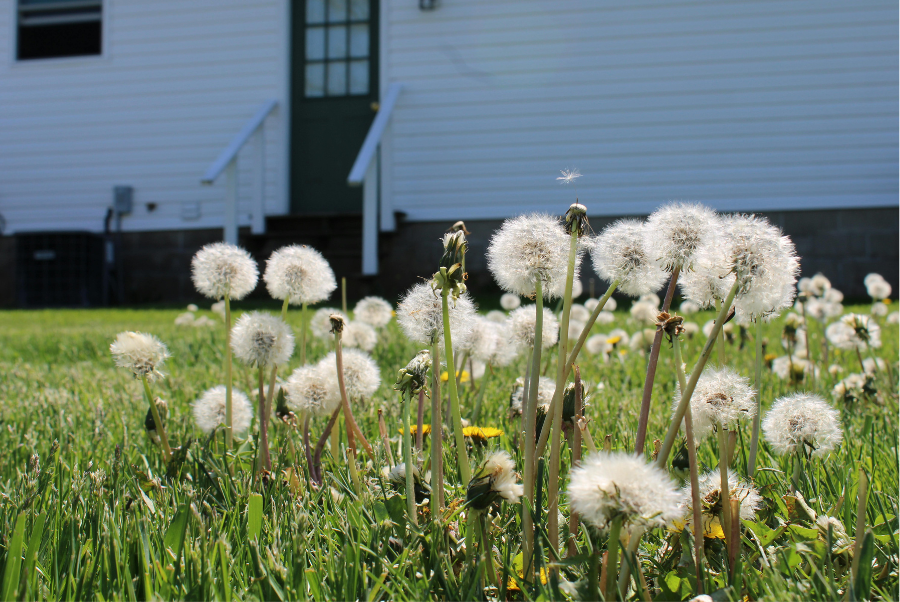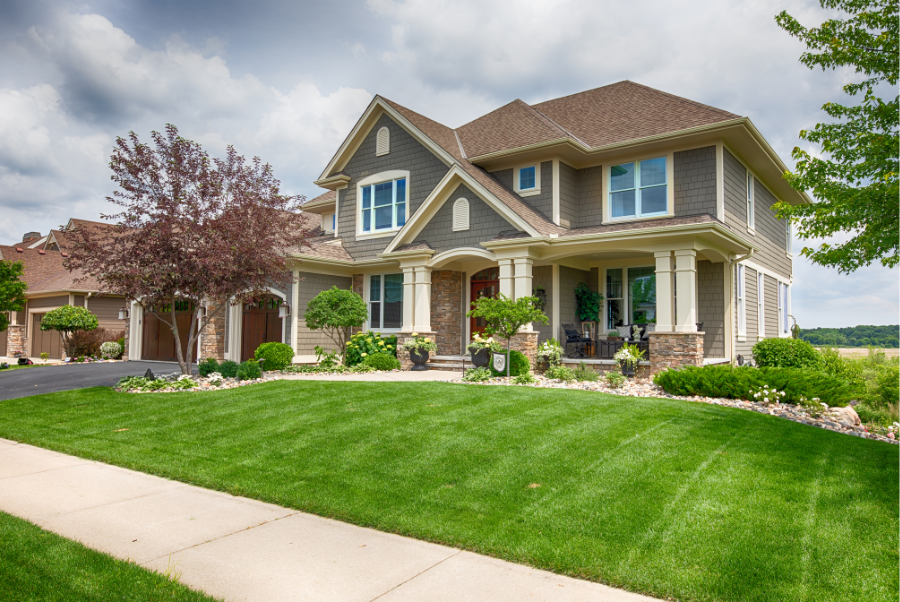
Why Lawn Aeration Is the Secret to a Thriving Lawn in Rhode Island
Maintaining a lush, vibrant lawn is no easy task—especially in Coventry, RI’s changing climate. From compacted soil to patchy grass, homeowners across Coventry, RI, and nearby towns often find themselves battling tired, unhealthy lawns despite their best efforts.
If your grass isn’t growing the way it should—or if you’re struggling with weak roots, water runoff, or uneven patches—the real issue might be happening underground.
That’s where lawn aeration comes in.
Lawn aeration is one of the most overlooked yet game-changing techniques in modern lawn care. By relieving soil compaction and improving the flow of air, water, and nutrients to the grassroots, it’s a powerful way to restore your lawn’s health from the ground up.
“Aeration can make the difference between a struggling lawn and a thriving one.”
— University of Rhode Island Master Gardeners Program
In this in-depth guide, we’ll explore the top 5 benefits of lawn aeration, explain why it’s crucial for homeowners and property managers in Rhode Island, and show you how this simple practice can transform your lawn into a greener, healthier landscape—all while boosting curb appeal and property value.
Whether you’re a new homeowner, a DIY lawn care enthusiast, or just looking for a sustainable way to maintain your yard, this guide is for you.
💡 Pro Tip:
If you’re unsure whether your lawn needs aeration or simply want expert guidance, reach out to your trusted local specialists at Doug Greenwood Landscaping Co. — located right here in Coventry, RI at 33 Carr St. Our team provides professional lawn aeration services tailored to Rhode Island soil and seasonal conditions.
What Is Lawn Aeration and Why Does It Matter?
If you’re aiming for a lawn that’s not just green but vibrantly healthy from the roots up, then understanding the benefits of lawn aeration is a must. So, what exactly is lawn aeration—and why should it matter to every Rhode Island homeowner?
✅ Definition: What Is Lawn Aeration?
Lawn aeration is the process of perforating the soil with small holes to allow air, water, and nutrients to penetrate deeper into the root zone of your grass. Over time, your lawn’s soil becomes compacted due to foot traffic, lawn equipment, and natural settling. When this happens, the roots struggle to breathe and absorb nutrients, leaving your grass thin, weak, and vulnerable to weeds and disease.
Aeration reverses this by breaking up compacted soil, creating space for roots to grow freely and absorb everything they need to flourish.
🛠️ How Lawn Aeration Works: Core vs. Spike Aeration
There are two main types of aeration, and knowing the difference can help you choose the best method for your lawn:
| Aeration Type | How It Works | Best For |
| Core Aeration | Removes plugs (or “cores”) of soil 2–3 inches deep | Clay-heavy or compacted lawns (common in RI) |
| Spike Aeration | Pokes holes in the soil without removing any plugs | Sandy soils or as a quick seasonal treatment |
“If you’re dealing with thick, compacted soil in Rhode Island, core aeration is the most effective approach for improving lawn vitality.”
— University of Rhode Island Master Gardeners
🌱 Why Aeration Matters for Long-Term Lawn Health
Without proper aeration, your lawn may suffer from:
- Thatch buildup (a dense layer of roots and debris that suffocates your grass)
- Shallow root systems that can’t reach moisture during dry periods
- Poor drainage, leading to puddling and fungal disease
- Patchy or uneven growth
On the other hand, a well-aerated lawn delivers long-term benefits like:
- Stronger, deeper roots
- Improved drought tolerance
- More efficient use of water and fertilizer
- A fuller, thicker appearance
- Resistance to common lawn pests and diseases
📅 When Is the Best Time to Aerate Your Lawn in Rhode Island?
In Rhode Island, the best times for lawn aeration are:
- Early Fall (September to early October) – This is the ideal time because the soil is still warm, which encourages fast recovery, and weed competition is lower.
- Spring (April to May) – A secondary window, especially if your lawn sees heavy foot traffic or snow compaction over the winter.
Timing is everything. Aerating during the wrong season—especially when grass is dormant—can do more harm than good.
👉 For a detailed seasonal lawn care calendar, check out this resource from the University of Rhode Island Master Gardeners.
1. Boosts Soil Health and Nutrient Absorption
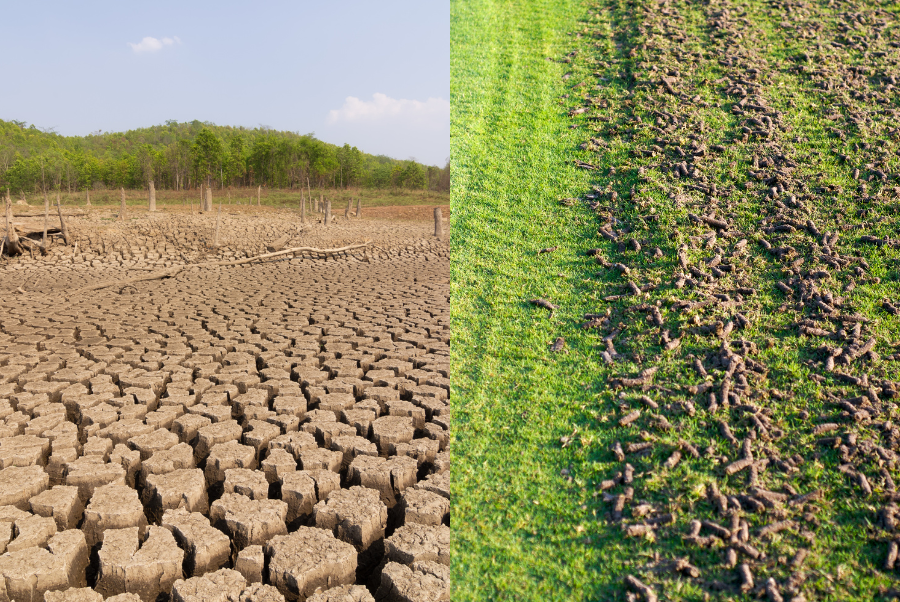
One of the most immediate and powerful benefits of lawn aeration is the restoration of soil health, especially in areas with heavy clay soil like Coventry, RI. Most lawn issues begin below the surface, where compacted soil chokes off the resources your grass needs to thrive.
🧱 What Is Compacted Soil and Why Is It a Problem?
Compacted soil occurs when soil particles are pressed tightly together, reducing the pore space between them. This can happen naturally over time due to:
- Foot traffic from people and pets
- Lawn equipment and mowers
- Heavy snow or rainfall
- Poor soil structure
When soil is compacted, it prevents air, water, and nutrients from reaching the grassroots—essentially starving your lawn from the bottom up. Even if you water and fertilize regularly, your efforts go to waste if these vital inputs can’t reach the roots.
💧 How Aeration Fixes Soil Compaction
Lawn aeration works by mechanically punching holes into the soil (core aeration) or spiking it (spike aeration). These openings allow:
- Oxygen to flow freely to the root zone, promoting healthy respiration
- Water to penetrate more deeply and be retained more effectively
- Nutrients from fertilizers to reach deeper soil layers and roots
This improves your lawn’s ability to absorb and utilize nutrients, making every watering and feeding session far more effective.
🌿 The Microbial Advantage: Encouraging Life Beneath the Surface
Aeration doesn’t just help grass—it activates the entire soil ecosystem. By improving air and moisture levels, you create the ideal environment for beneficial soil microbes to thrive.
These microscopic organisms help:
- Break down organic material into plant-ready nutrients
- Improve soil structure
- Suppress harmful fungi and bacteria
“Aeration stimulates microbial activity, which is crucial for maintaining nutrient-rich soil and long-term turf health.”
— Cornell Cooperative Extension, Soil Management Guide
You can learn more about the importance of microbial activity and soil aeration from Cornell Cooperative Extension.
🌱 Root Development: The Foundation of a Healthier Lawn
When water and nutrients are finally able to reach the root zone, your grass responds by growing deeper and stronger roots. This not only improves the lawn’s ability to withstand drought and stress, but also helps it:
- Resist weeds and pests
- Recover faster from foot traffic and mowing
- Stay green and lush longer into the season
Healthy roots = healthy lawn. And aeration is the key to unlocking root potential.
📍Local Tip: At Doug Greenwood Landscaping Co., we specialize in lawn aeration tailored to the soil conditions in Kent County, ensuring your lawn gets the deep-root nourishment it needs. Book an appointment today to give your grass the advantage it deserves.
2. Improves Lawn Drainage and Reduces Runoff
Another essential benefit of lawn aeration is how dramatically it improves lawn drainage—a critical issue for many Rhode Island homeowners dealing with soggy, patchy grass or water pooling in uneven areas.
💦 How Aeration Solves Water Pooling and Thatch Buildup
If you’ve noticed puddles on your lawn after it rains, or that water seems to run off instead of soaking in, you’re likely dealing with poor drainage caused by compacted soil or a thick layer of thatch (a dense layer of dead roots and organic matter above the soil).
Aeration helps by:
- Breaking up compacted areas to allow water to flow naturally into the soil
- Loosening the thatch layer, giving it space to decompose and allow nutrients to pass through
- Increasing soil porosity, which improves absorption and reduces surface runoff
This process turns standing water zones into productive root zones, improving both appearance and grass health.
🌍 Reduces Runoff and Soil Erosion on Sloped Lawns
If your yard includes a slope or hill, you’re more likely to deal with erosion as water rushes downhill, taking topsoil—and your lawn’s nutrients—with it. Lawn aeration combats this by:
- Allowing deeper water infiltration, reducing surface flow
- Strengthening root systems, which anchor the soil and help it resist erosion
- Evening out moisture distribution, so your entire lawn benefits uniformly
Over time, you’ll notice fewer bald patches at the base of slopes and healthier grass across elevations.
🌱 Cuts Down on Chemical and Water Waste
An over-compacted lawn can be deceptively thirsty. Water and fertilizers tend to run off or pool rather than soak in, leading to:
- Wasted water that drives up utility costs
- Overuse of lawn chemicals, which can leach into local waterways
- Poor results from even the best products due to poor penetration
Aerating your lawn helps maximize the efficiency of every drop of water and ounce of fertilizer. This not only saves you money—it makes your lawn care practices more effective and sustainable.
“Soil aeration enhances water use efficiency and minimizes nutrient runoff—both key principles of eco-friendly turf care.”
— National Association of Landscape Professionals
🌎 Eco-Conscious Lawn Care That Makes a Difference
If you’re among the growing number of eco-conscious Rhode Island homeowners, lawn aeration is one of the most impactful changes you can make. It aligns perfectly with sustainable landscaping goals by:
- Reducing reliance on synthetic inputs
- Improving water conservation
- Promoting natural microbial activity over chemical control
By investing in aeration, you’re not just helping your yard—you’re supporting a healthier local ecosystem.
📍Local Tip: Many homeowners in Coventry and Kent County experience seasonal flooding and poor water absorption. At Doug Greenwood Landscaping Co., we tailor lawn aeration services to tackle these issues head-on. Contact us today to improve your lawn’s drainage while protecting the environment.
3. Helps Eliminate Lawn Thatch and Promote Greener Grass
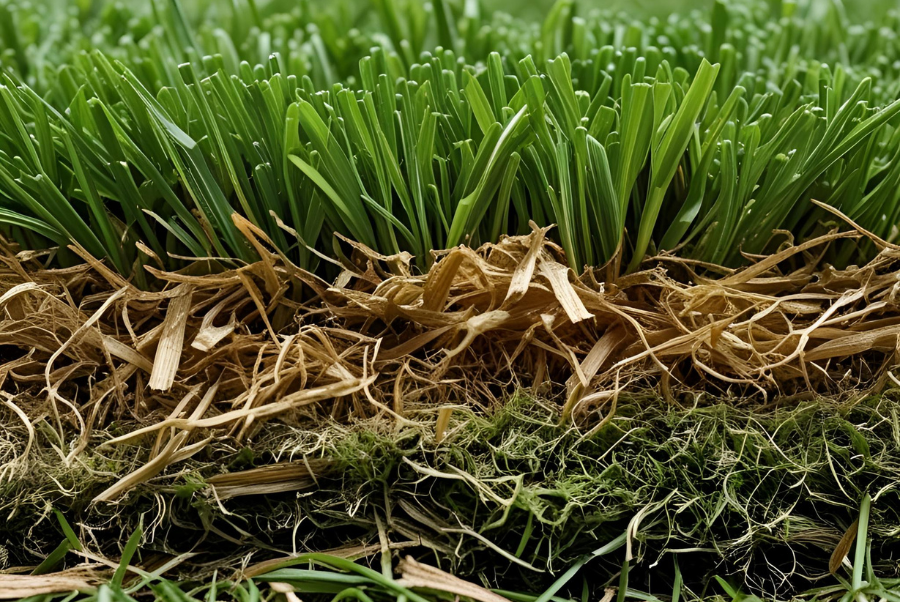
A lush, green lawn doesn’t just look good—it signals health from the soil up. One of the lesser-known but incredibly valuable benefits of lawn aeration is its ability to break down lawn thatch, a silent lawn killer hiding in plain sight.
🧵 What Is Lawn Thatch and Why Is It Harmful?
Lawn thatch is a tightly woven layer of dead grass stems, roots, and other organic matter that accumulates between the soil surface and green grass blades.
While a thin layer of thatch (½ inch or less) can protect the soil, excessive thatch creates major problems:
- Prevents water, nutrients, and air from reaching the roots
- Becomes a breeding ground for pests and fungi
- Traps heat and moisture, stressing the turf
- Leads to a spongy, uneven lawn texture
In Rhode Island’s humid climate, thatch buildup can become a persistent issue if not managed properly.
🛠️ How Aeration Helps Break Down Thatch Naturally
Rather than removing thatch manually (a labor-intensive process), core aeration provides a natural and more effective solution. Here’s how it works:
- Pulls plugs of soil and thatch from the lawn, introducing oxygen and microbes into the thatch layer
- Accelerates decomposition of organic material by increasing microbial activity
- Improves water flow and nutrient access, helping grassroots grow through and break up thatch from below
Over time, consistent aeration will reduce thatch buildup and improve turf performance, without harsh dethatching tools or chemicals.
🌿 Thicker, Greener Grass That Looks and Feels Healthier
When thatch is minimized and nutrients reach the root zone, your lawn responds with denser, more vibrant turf. Healthy grass spreads via rhizomes and tillers, thickening naturally and covering bare spots.
Benefits of a thicker lawn include:
- A softer, more enjoyable yard for kids and pets
- Increased photosynthesis, leading to deeper green coloration
- Better resistance to drought and disease
You’ll notice the difference visually and underfoot—aerated lawns feel noticeably softer and healthier.
🚫 Thicker Lawns Crowd Out Weeds Naturally
Weeds love weak, sparse turf. When grass roots are starved and thatch dominates, weeds move in and steal valuable space and resources.
By encouraging healthy grass growth and soil aeration, you’re creating natural weed resistance without excessive herbicide use. Thick, healthy turf shades out invasive species like:
- Crabgrass
- Dandelions
- Clover
- Ground ivy
This not only boosts curb appeal—it aligns with eco-friendly landscaping practices by reducing your reliance on chemical weed killers.
📍Local Tip: At Doug Greenwood Landscaping Co., we’ve helped hundreds of Rhode Island homeowners turn thin, patchy lawns into thick, green showcases. Our lawn aeration services are customized to your property’s soil type and thatch condition. Schedule your consultation today to get started.
4. Prepares Your Lawn for Overseeding and Fertilizing
One of the most strategic benefits of lawn aeration is how it sets the stage for successful overseeding and fertilization—especially during the fall and spring seasons, which are optimal for grass growth in Rhode Island’s temperate climate.
🍂 Why Fall and Spring Are the Best Times to Aerate and Overseed
In Rhode Island, the early fall (late August through October) and early spring (April through May) offer the perfect conditions for lawn rejuvenation:
- Cooler temperatures reduce stress on new grass
- Natural rainfall helps seeds germinate
- Weeds are less aggressive than in summer
- Grass has time to establish roots before extreme temperatures hit
Aerating your lawn right before overseeding ensures the seeds land in loose, oxygen-rich soil—dramatically increasing the likelihood of germination and thick turf growth.
“Fall aeration is essential for successful overseeding and root development. The results are stronger, healthier lawns by spring.”
— University of Rhode Island Master Gardener Program
🌱 How Aeration Improves Seed-to-Soil Contact
One of the biggest challenges with overseeding is ensuring the grass seed actually makes contact with the soil. If seeds sit on thatch or matted grass, they’re unlikely to germinate. Core aeration solves this by:
- Creating thousands of holes in the soil where seeds can settle
- Exposing bare soil, ideal for grass seed penetration
- Increasing light and moisture access, which encourages germination
A well-aerated lawn acts like a sponge—absorbing seeds, nutrients, and water more efficiently.
🌾 Ideal Conditions for New Grass Growth
After aeration, your lawn is essentially “reset”—it’s loose, breathable, and primed for new life to take root. This means:
- Less competition from weeds and thatch
- Room for roots to expand deep into the soil
- A microclimate perfect for rapid seed sprouting
Whether you’re patching bare spots or thickening an entire lawn, aeration ensures new seedlings get a strong, healthy start.
💪 Maximizes Fertilizer and Lawn Treatment Efficiency
Fertilizers and other treatments are only effective when they reach the roots. Compacted soil and thick thatch act like barriers, blocking absorption and wasting product.
By aerating first, you allow:
- Nutrients to penetrate deep into the root zone
- Improved distribution of granular or liquid treatments
- Longer-lasting effects, as treatments reach where they’re needed most
Think of aeration as unlocking your lawn’s potential. Every drop of fertilizer or amendment will go further—and perform better—when the soil is properly aerated.
📍Local Tip: In Coventry and the greater Kent County area, soil conditions often become compacted from heavy foot traffic and seasonal weather extremes. At Doug Greenwood Landscaping Co., we time our aeration services to sync perfectly with Rhode Island’s overseeding and fertilizing windows. Book your aeration appointment now to prepare for a lush, vibrant lawn year-round.
5. Enhances Curb Appeal and Property Value
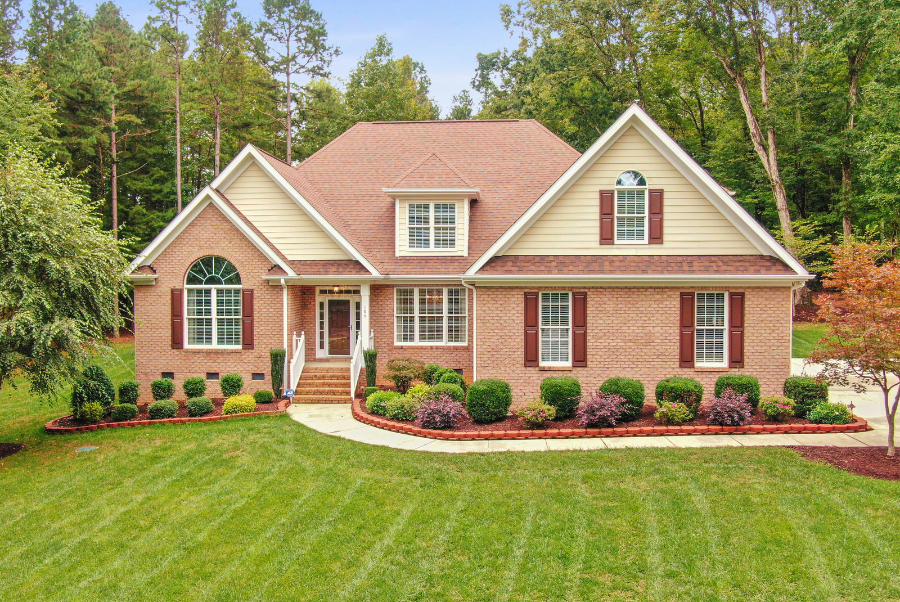
Your lawn is more than just grass—it’s a living first impression. For homeowners, sellers, and real estate professionals alike, one of the most practical and visual benefits of lawn aeration is how dramatically it improves curb appeal and contributes to overall property value.
🏡 First Impressions Matter for Home Sellers and Real Estate Agents
In today’s competitive housing market, curb appeal can make or break a sale. According to the National Association of Realtors:
“Well-maintained landscaping, including lush lawns, can increase home value by up to 10%.”
— NAR 2023 Report on Outdoor Features
Buyers tend to make judgments within the first 30 seconds of seeing a property. A brown, patchy lawn can create doubt about the overall maintenance of the home. On the other hand, a thick, green lawn signals care, quality, and attention to detail.
Aeration helps achieve this visual impact faster and more sustainably than cosmetic fixes alone.
🌱 Healthier, Thicker Lawns Create a Standout Landscape
Aerated lawns grow thicker, stay greener, and resist pests—all signs of a healthy yard. From the street, these lawns look:
- Fuller and more vibrant
- Even in color and texture
- Free of bare patches, weeds, and dry spots
This enhanced visual appeal frames your home, making it pop in photos and walk-throughs. For families who aren’t selling, a well-aerated lawn simply means a more enjoyable, beautiful space to relax, play, and entertain.
💸 Lawn Aeration as a Long-Term Investment Strategy
Many homeowners treat landscaping reactively—only tackling issues when they arise. But like HVAC tune-ups or roof inspections, regular lawn aeration is preventative maintenance that:
- Preserves soil quality
- Reduces long-term lawn repair costs
- Improves the lifespan of grass, fertilizers, and irrigation systems
The cost of annual aeration is modest—especially compared to full lawn renovations or ongoing patching. For real estate investors or property managers in Rhode Island, aeration is a high-ROI lawn care strategy that increases rental and resale appeal.
✅ Before & After Case Study: Coventry Home Transformation
Before Aeration:
A homeowner in Coventry, RI reached out to Doug Greenwood Landscaping Co. in early September. Their front lawn was struggling with:
- Compacted soil from years of foot traffic
- Excessive thatch blocking water absorption
- Sparse, patchy grass coverage
After One Season of Aeration & Overseeding:
Following a fall aeration and overseeding plan:
- Grass density improved by 35% within 8 weeks
- Thatch layer was reduced by nearly 50%
- Lawn color shifted from pale green to deep, vibrant green
The homeowner noted a dramatic change in how neighbors and visitors perceived their home—and saw a significant boost in pride and use of their outdoor space.
📍Local Advantage: At Doug Greenwood Landscaping Co., we specialize in aeration strategies tailored for Rhode Island lawns. Whether you’re selling soon or just want to love your yard again, we’re here to help. Schedule your consultation today.
How Often Should You Aerate Your Lawn in Rhode Island?
When it comes to reaping the full benefits of lawn aeration, timing and frequency are everything. Not every lawn is the same, especially in a place like Rhode Island, where weather patterns, soil types, and turf species can vary widely across neighborhoods.
Understanding how often to aerate—and whether to DIY or call in a professional—can mean the difference between a lush green oasis and a struggling patch of grass.
🌾 Frequency Based on Lawn Type and Soil Composition
In Rhode Island, most lawns are made up of cool-season grasses like Kentucky bluegrass, fine fescue, or perennial ryegrass. These grasses thrive in the cooler spring and fall months, which also happen to be the best times to aerate.
Here’s a quick guide based on your lawn type:
| Lawn Type or Soil Condition | Aeration Frequency | Notes |
| Heavy Clay Soils | 1–2 times per year | Clay compacts easily; spring and fall aeration often needed |
| Sandy Soils | Every 2 years | Less prone to compaction; aerate as needed |
| High Foot Traffic Areas | Annually | Compaction from kids, pets, or parties demands yearly care |
| Thatch-Prone Lawns | Annually | Helps break down thick thatch layers |
| New Lawns (1–2 years old) | Annually | Helps establish strong root systems |
Pro Tip: Most Rhode Island lawns benefit from annual fall aeration. This timing allows roots to grow deeper before winter dormancy.
🚩 Signs Your Lawn Needs Aeration
Not sure if your lawn actually needs aeration? Look out for these telltale signs:
- Water pools on your lawn after rain (poor drainage)
- Spongy or squishy feeling underfoot (thatch buildup)
- Grass grows unevenly or appears thin and weak
- Browning even with watering and fertilization
- Difficulty inserting a screwdriver into the soil
If you’re seeing these symptoms, you’re likely missing out on the key benefits of lawn aeration—better soil health, thicker grass, and less water waste.
🔧 DIY vs. Professional Lawn Aeration Services
While DIY aeration tools are available at most hardware stores, they often fall short for larger or heavily compacted lawns. Here’s how the two options compare:
| Aspect | DIY Aeration | Professional Aeration (Doug Greenwood Landscaping Co.) |
| Equipment | Manual or rented machine | Commercial-grade core aerators |
| Cost | Lower upfront | Higher initial, better long-term ROI |
| Time | Labor-intensive | Quick and efficient |
| Results | Varies by effort | Deep, even aeration throughout lawn |
| Expertise | None | Local knowledge of Rhode Island soil and grass |
If your lawn is small and lightly compacted, DIY may suffice once in a while. But for lasting results, professional aeration ensures deeper plugs, faster recovery, and a real return on investment.
DIY Lawn Aeration vs. Hiring a Local Expert
If you’ve been researching the benefits of lawn aeration, you’re likely wondering: Should I do it myself or hire a professional? While both options have their merits, the best choice often depends on your time, skill level, lawn size, and your location in Rhode Island.
Let’s break it down.
🛠️ Pros and Cons of Renting an Aerator
Renting a core aerator from your local hardware or garden supply store is a popular route for DIY homeowners. However, this path comes with both upsides and drawbacks.
✅ Pros:
- Lower upfront cost than hiring a service
- Schedule flexibility — do it on your own time
- Great learning experience for lawn care enthusiasts
❌ Cons:
- Physically demanding — machines are heavy and awkward
- Uneven results — inconsistent depth and spacing
- Risk of damage to lawn or sprinkler systems
- Time-consuming for larger or sloped properties
“The average rental aerator weighs between 200–300 lbs and can be tough to maneuver without experience,” says Turf Magazine. “This often leads to uneven aeration, which limits effectiveness.”
⏳ Time, Effort, and Risk of DIY Lawn Aeration
Aerating might look easy—but there’s more to it than just poking holes in your lawn.
DIY aeration takes time—anywhere from 3 to 6 hours depending on your lawn’s size. If your soil is dry or compacted, even more effort is required to get good results.
You also run the risk of:
- Missing key areas, leaving some spots untouched
- Damaging sprinkler heads, tree roots, or buried utilities
- Injuring yourself if you’re unfamiliar with heavy equipment
💡 Benefits of Professional Equipment and Expertise
When you hire a company like Doug Greenwood Landscaping Co., you’re not just getting someone to run a machine—you’re getting precision, expertise, and results.
Here’s what sets professional lawn aeration apart:
- Deep, uniform plugs using commercial-grade equipment
- Local turf knowledge for timing and best practices
- Bundled services (aeration + overseeding + fertilizing)
- Zero stress for the homeowner
Professionals also know how to tailor the aeration process based on grass type, weather conditions, and soil composition—which is critical for lawns in Rhode Island’s seasonal climate.
🏡 Why Choose Doug Greenwood Landscaping Co.?
As a locally trusted name in Coventry, Rhode Island, Doug Greenwood Landscaping Co. offers:
- Experienced technicians trained in local soil and turf conditions
- State-of-the-art aeration tools for consistent performance
- Customized care plans for residential and commercial lawns
- Eco-friendly methods aligned with sustainable landscaping
📍Ready to take the guesswork out of aerating your lawn?
Let Doug Greenwood Landscaping Co. handle it for you.
👉 Book an appointment today
Common Questions About the Benefits of Lawn Aeration (FAQ Style)
Lawn aeration might seem simple, but if you’re like most Rhode Island homeowners, you’ve got questions. Below, we address the most frequently asked questions about aeration.
❓ Will Lawn Aeration Damage My Grass?
No—when done properly, lawn aeration will not damage your grass. In fact, it helps your lawn recover and thrive by reducing soil compaction and promoting root growth.
You might see small plugs of soil left behind after core aeration, but these are temporary and beneficial. The holes left behind will fill in quickly, leading to stronger, thicker turf over time.
“Aeration is like a deep breath for your lawn—it might look a little messy at first, but it delivers long-term health benefits,” says the University of Massachusetts Amherst Extension.
🌧️ Can I Aerate After Rain?
Yes—but timing matters. Light to moderate rainfall before aeration can soften the soil, making it easier for the aerator to penetrate. However, avoid aerating immediately after heavy rain, as saturated soil may clog machines and damage turf.
The ideal soil condition for aeration is moist but not muddy. A good rule of thumb: if you can walk on the lawn without sinking or leaving footprints, it’s likely okay to aerate.
🗓️ In Coventry, RI, consider checking the local weather forecast and plan aeration a day or two after rain, or water your lawn 24 hours before aerating.
🧪 What Should I Do After Aerating?
Post-aeration care is just as important as the aeration process itself. Here’s a quick checklist:
| Task | Purpose |
| Apply grass seed | Fills in bare spots and thickens turf |
| Spread fertilizer | Delivers nutrients to newly exposed roots |
| Topdress with compost | Adds organic matter and improves soil structure |
| Water deeply | Helps new seed and nutrients penetrate |
| Avoid mowing for 7–10 days | Allows recovery and growth |
This is the perfect time to schedule overseeding or lawn treatments—a freshly aerated lawn absorbs everything more effectively.
Need help? Doug Greenwood Landscaping Co. offers full-service aeration and post-care packages tailored for Rhode Island lawns.
🌱 Does Aeration Control Weeds?
Indirectly, yes. While lawn aeration isn’t a weed killer, it creates conditions that discourage weed growth.
Here’s how:
- Thicker turf from improved root development leaves less room for weeds
- Healthier soil promotes grass dominance over invasive species
- Better water distribution prevents overly dry or soggy patches where weeds thrive
Incorporating aeration into your annual lawn care plan can significantly reduce the chance of weed takeover—especially when combined with fertilization and overseeding.
Bonus Tip: Combine Aeration With Eco-Friendly Lawn Care Practices
While understanding the benefits of lawn aeration is essential, pairing it with eco-friendly landscaping practices can take your lawn’s health—and your environmental impact—to the next level.
At Doug Greenwood Landscaping Co., we believe that great lawns shouldn’t come at the cost of the environment. That’s why we encourage homeowners in Coventry, RI, to align aeration with these sustainable lawn care strategies:
♻️ Mulching and Composting: Nature’s Free Fertilizer
Instead of bagging your grass clippings or fall leaves, consider mulching them into the lawn. When combined with aeration:
- Organic matter fills aeration holes and improves soil structure
- Decomposed material releases slow, natural nutrients
- Reduces landfill waste and keeps lawns lush without synthetic additives
Similarly, composting kitchen and garden waste gives you a nutrient-rich amendment you can spread post-aeration for maximum benefit.
🌾 Plant Native or Low-Maintenance Grass Varieties
Aeration opens the door—literally—for new seeds to establish deep roots. Take advantage of this by overseeding with native or drought-resistant grasses that:
- Require less watering and fertilization
- Thrive in Rhode Island’s seasonal climate
- Naturally crowd out weeds
Options like fine fescues or Kentucky bluegrass blends are great for cool-season lawns common across Kent County.
🚫 Reduce Chemical Dependency
One of the most overlooked benefits of lawn aeration is how it helps reduce reliance on chemical herbicides and synthetic fertilizers.
- Aerated lawns absorb nutrients better, meaning less product is needed
- Healthier roots outcompete weeds organically
- Improved drainage prevents lawn diseases caused by stagnant moisture
This not only protects local groundwater but is safer for children, pets, and pollinators.
🐛 Support Soil Biodiversity and Ecosystem Health
When you aerate your lawn and reduce compaction, you support a healthier underground ecosystem. Earthworms, fungi, and beneficial bacteria thrive in aerated, organic-rich soil.
This improves:
- Soil fertility
- Nutrient cycling
- Natural disease resistance
By working with nature rather than against it, you create a lawn that is resilient, vibrant, and low-maintenance.
If you’re passionate about sustainable lawn care, Doug Greenwood Landscaping Co. is your local partner in eco-conscious landscaping. We proudly serve Coventry and surrounding Rhode Island communities with services that combine performance and environmental stewardship.
📍 Ready to green your yard the natural way?
👉 Book an appointment today with our team of local experts!
Final Thoughts: Is Lawn Aeration Worth It?
Absolutely—lawn aeration is one of the most underrated yet impactful practices you can do for your lawn’s long-term health and appearance. If you’ve been struggling with compacted soil, patchy grass, pooling water, or stubborn weeds, aeration could be the game-changer you’ve been waiting for.
Let’s recap the 5 game-changing benefits of lawn aeration:
- Boosts Soil Health and Nutrient Absorption
Aeration allows roots to access oxygen, water, and nutrients more effectively, creating an environment where grass thrives naturally. - Improves Lawn Drainage and Reduces Runoff
Prevent standing water and protect against erosion, especially on sloped properties. Better drainage means fewer lawn diseases and lower water bills. - Eliminates Lawn Thatch and Promotes Greener Grass
Say goodbye to thatch and hello to lush, thick turf. A well-aerated lawn grows stronger and more vibrant. - Prepares Your Lawn for Overseeding and Fertilizing
Aeration enhances seed-to-soil contact, making your overseeding and fertilizing efforts far more effective and budget-friendly. - Enhances Curb Appeal and Property Value
A healthy, uniform lawn makes a memorable first impression, which is a major advantage for home sellers, real estate agents, and proud homeowners alike.
🏡 Long-Term ROI You Can See and Feel
While aeration may not deliver overnight miracles, the long-term results are well worth the investment—especially when done at the right time of year in Rhode Island, such as early fall or spring.
A single aeration session can unlock months of better grass growth, water retention, and weed resistance. Multiply that over years and you’re talking about a lawn that performs better, looks better, and requires less input from you.
Think of aeration not as a chore—but as preventative care for your landscape.
🌱 Don’t Wait—Your Lawn Deserves Better Now
Whether you’re a seasoned DIY lawn enthusiast or a new homeowner eager to learn, the time to act is before the next growing season begins. Healthy lawns start from the ground up—literally.
Doug Greenwood Landscaping Co. is proud to help homeowners throughout Coventry, Rhode Island, and surrounding areas reap the full benefits of lawn aeration with professional tools, expert timing, and a deep understanding of local soil and grass conditions.
📅 Book your lawn aeration appointment today and see the results by next season.
👉 Click here to contact us
Ready for a Healthier Lawn? Book Your Lawn Aeration Service Today
There’s no better time than now to invest in your lawn’s future. Whether you’re dealing with compacted soil, thinning grass, or stubborn weeds, aeration is the key to a greener, healthier yard—and Doug Greenwood Landscaping Co. is here to help.
As a trusted local expert based in Coventry, RI, we proudly serve homeowners and property managers throughout West Warwick, Cranston, Warwick, East Greenwich, and surrounding Rhode Island communities. Our team uses professional-grade equipment and local knowledge to deliver results that last season after season.
✅ Boost your lawn’s vitality
✅ Improve curb appeal and property value
✅ Support sustainable, low-maintenance landscaping
👉 Book your lawn aeration appointment today and let us help you create the lawn you’ve always wanted—healthy from the roots up.


